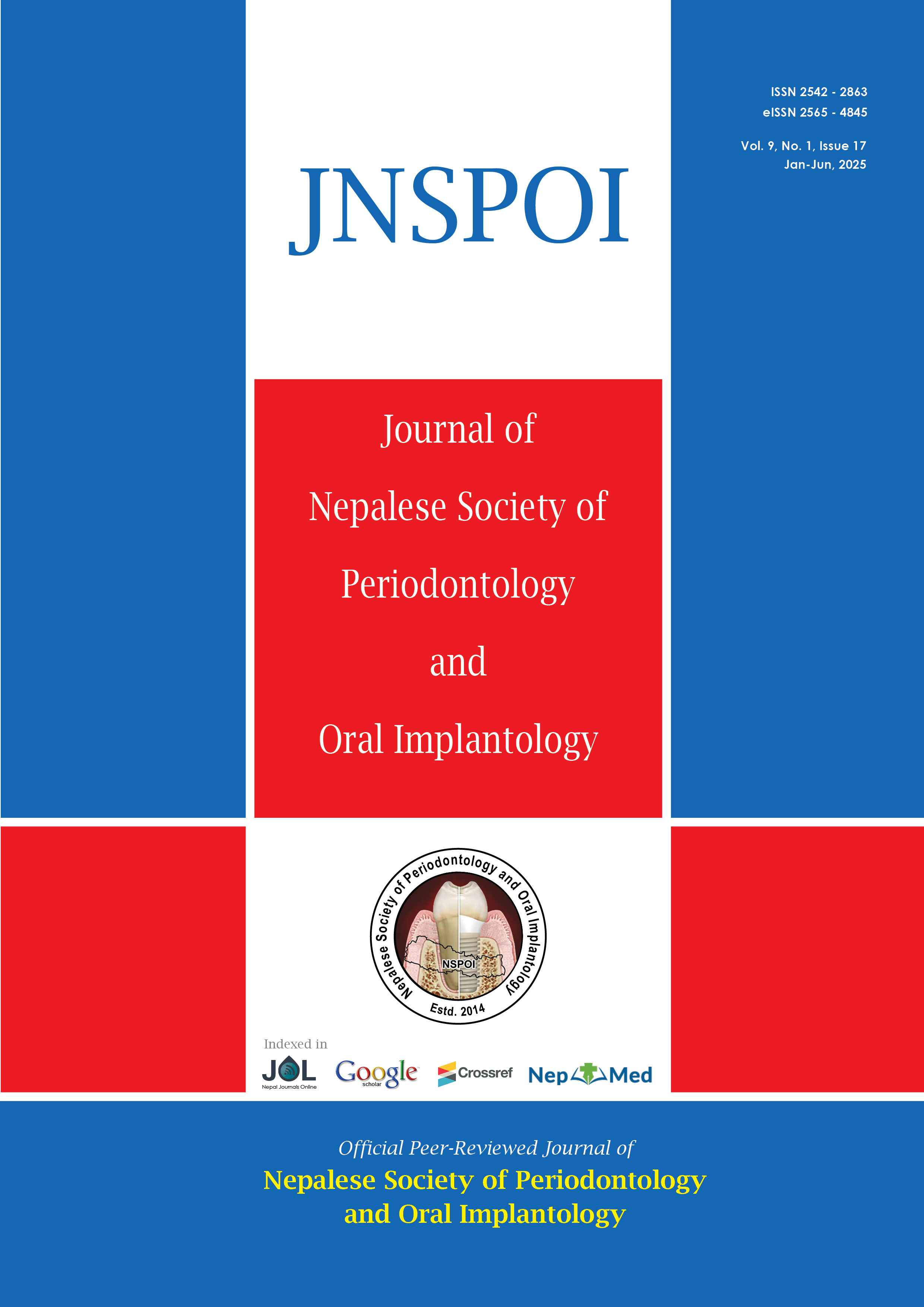Abstract
Introduction: Gingival phenotype plays an important role in maintenance of healthy periodontium. Therefore, it is crucial to determine
gingival phenotype before any dental related therapy as it helps in decision making process for better prognosis.
Objective: To evaluate the type of gingival phenotypes in maxillary central incisor teeth and also to test possible effects of probing depth,
width of keratinised gingiva, age, gender, religion, smoking, and brushing habits on the gingival phenotype among patients.
Methods: This analytical cross-sectional study was conducted in 268 systemically healthy patients aged 20-50 years in the Department
of Periodontology and Oral Implantology, National Medical College from 2023 April and 2024 October after institutional ethical approval.
Convenience sampling method was utilised. The gingival phenotype was measured via the probe transparency method. The width of the
keratinised gingiva and probing depth were measured in nearest millimetre (mm). Chi-square tests and independent t-tests were applied to
determine the possible associations between the dependent and independent variables at the 95% confidence level (p ≤0.05).
Results: Out of 268 patients, 167 (62.3%) had thick gingival phenotype while 101 (37.7%) had thin gingival phenotype. The average width
of keratinised gingiva of right and left central incisors were 5.17±1.46 mm and 5.34±1.58 mm respectively, whereas average probing depth
were 1.62±0.62 mm and 1.70±0.71 mm respectively. Both the mean width of keratinised gingiva and probing depth were significantly
different between thin and thick gingival phenotype (p <0.001).
Conclusions: A thicker gingival phenotype was more prevalent in maxillary central incisor teeth. The width of keratinised gingiva was
greater in thick than in thin gingival phenotypes. By contrast, greater probing depths were measured for the thick than for thin gingival
phenotypes.
References
Consensus report of workgroup 3 of the 2017 World Workshop on the Classification of Periodontal and Peri-Implant Diseases and
Conditions. J Periodontol. 2018;89(1):S237-48.
2. Shah HK, Sharma S, Shrestha S. Gingival biotype classification, assessment and clinical importance: A review. J Nepal Soc Perio Oral
Implantol. 2020;4(8):83-8.
3. Shrestha S, Goel K, Niraula SR. Assessment of gingival biotypes in patients visiting a tertiary care centre in eastern Nepal. J Nepal
Health Res Counc. 2020;18(3):472-7.
4. Collins JR, Pannuti CM, Veras K, et al. Gingival phenotype and its relationship with different clinical parameters: A study in a Dominican
adult sample. Clin Oral Investig. 2021;25(8):4967-73.
5. Goaslind GD, Robertson PB, Mahan CJ, et al. Thickness of facial gingiva. J Periodontol. 1977;48(12):768-71.
6. von Elm E, Altman DG, Egger M, et al.; STROBE Initiative. The Strengthening the Reporting of Observational Studies in Epidemiology
(STROBE) statement: Guidelines for reporting observational studies. J Clin Epidemiol. 2008;61(4):344-9.
7. Kan JY, Morimoto T, Rungcharassaeng K, et al. Gingival biotype assessment in the aesthetic zone: Visual versus direct measurement.
Int J Periodontics Restorative Dent. 2010;30(3):237-43.
8. Joshi N, Agarwal MC, Madan E, et al. Gingival biotype and gingival bioform: Determining factors for periodontal disease progression
and treatment outcome. Int J Sci Study. 2016;4(3):220-5.
9. Abraham S, Deepak KT, Ambili R, et al. Gingival biotype and its clinical significance: A review. Saudi J Dent Res. 2014;5:3-7.
10. Kim DM, Bassir SH, Nguyen TT. Effect of gingival phenotype on the maintenance of periodontal health: An American Academy of
Periodontology best evidence review. J Periodontol. 2020;91(3):311-38.
11. Moosa Y, Samaranayake L, Pisarnturakit PP. The gingival phenotypes and related clinical periodontal parameters in a cohort of Pakistani
young adults. Heliyon. 2024;10(2):e24219.
12. De Rouck T, Eghbali R, Collys K, et al. The gingival biotype revisited: Transparency of the periodontal probe through the gingival
margin as a method to discriminate thin from thick gingiva. J Clin Periodontol. 2009;36(5):428-33.
13. Shao Y, Yin L, Gu J, et al. Assessment of periodontal biotype in a young Chinese population using different measurement methods.
Sci Rep. 2018;8(1):11212.
14. Zhang Y, Chen F, Kang N, et al. Clinical and computed tomographic evaluations of periodontal phenotypes in a Chinese population: A
cross-sectional study. Clin Oral Investig. 2023;27(7):3569-77.
15. da Costa FA, Perussolo J, Dias DR, et al. Identification of thin and thick gingival phenotypes by two transparency methods: A diagnostic
accuracy study. J Periodontol. 2023;94(5):673-82.
16. Eger T, Müller HP, Heinecke A. Ultrasonic determination of gingival thickness. Subject variation and influence of tooth type and clinical
features. J Clin Periodontol. 1996;23(9):839-45.
17. Cook DR, Mealey BL, Verrett RG, et al. Relationship between clinical periodontal biotype and labial plate thickness: An in vivo study.
Int J Periodontics Restorative Dent. 2011 Jul-Aug;31(4):345-54.
18. Kolte R, Kolte A, Mahajan A. Assessment of gingival thickness with regards to age, gender, and arch location. J Indian Soc Periodontol.
2014;18(4):478-81.
19. Vandana KL, Savitha B. Thickness of gingiva in association with age, gender, and dental arch location. J Clin Periodontol.
2005;32(7):828-30.
20. Müller HP, Eger T. Gingival phenotypes in young male adults. J Clin Periodontol. 1997;24(1):65-71.
21. Egreja AM, Kahn S, Barceleiro M, et al. Relationship between the width of the zone of keratinised tissue and thickness of gingival
tissue in the anterior maxilla. Int J Periodontics Restorative Dent. 2012;32(5):573-9.
22. Shah R, Sowmya NK, Mehta DS. Prevalence of gingival biotype and its relationship to clinical parameters. Contemp Clin Dent.
2015;6(Suppl 1):S167-71.
23. Fischer KR, Künzlberger A, Donos N, et al. Gingival biotype revisited-novel classification and assessment tool. Clin Oral Investig.
2018;22(1):443-48.
24. Olsson M, Lindhe J, Marinello CP. On the relationship between crown form and clinical features of the gingiva in adolescents. J Clin
Periodontol. 1993;20(8):570-7.
25. Müller HP, Könönen E. Variance components of gingival thickness. J Periodontal Res. 2005;40(3):239-44.
26. Hussain MA, Singh SK, Naz S, et al. Predictors of apical periodontitis in root canal treated teeth from an adult Nepalese subpopulation:
A cross-sectional study. BMC Oral Health. 2024;24(1):400.

